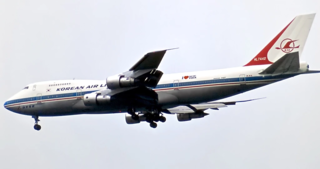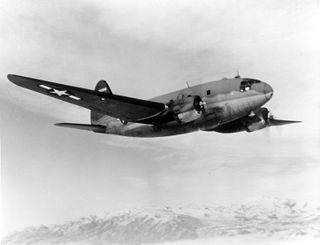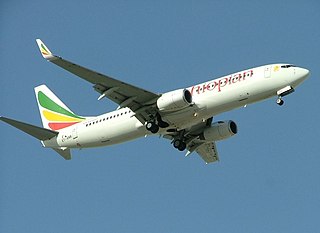Related Research Articles

Fly-by-wire (FBW) is a system that replaces the conventional manual flight controls of an aircraft with an electronic interface. The movements of flight controls are converted to electronic signals transmitted by wires, and flight control computers determine how to move the actuators at each control surface to provide the ordered response. It can use mechanical flight control backup systems or use fully fly-by-wire controls.

The Wright brothers, Orville Wright and Wilbur Wright, were American aviation pioneers generally credited with inventing, building, and flying the world's first successful motor-operated airplane. They made the first controlled, sustained flight of a powered, heavier-than-air aircraft with the Wright Flyer on December 17, 1903, four miles south of Kitty Hawk, North Carolina, at what is now known as Kill Devil Hills. The brothers were also the first to invent aircraft controls that made fixed-wing powered flight possible.

Korean Air Lines Flight 007 (KE007/KAL007) was a scheduled Korean Air Lines flight from New York City to Seoul via Anchorage, Alaska. On September 1, 1983, the flight was shot down by a Soviet Sukhoi Su-15 interceptor. The Boeing 747 airliner was en route from Anchorage to Seoul, but owing to a navigational mistake made by the crew, the airliner drifted from its original planned route and flew through Soviet prohibited airspace. The Soviet Air Forces treated the unidentified aircraft as an intruding U.S. spy plane, and destroyed it with air-to-air missiles, after firing warning shots. The Korean airliner eventually crashed into the sea near Moneron Island west of Sakhalin in the Sea of Japan. All 269 passengers and crew aboard were killed, including Larry McDonald, a United States representative. The Soviet Union found the wreckage under the sea two weeks later on September 15 and found the flight recorders in October, but this information was kept secret by the Soviet authorities until after the country's collapse.

The Convair 880 is an American narrow-body jet airliner produced by the Convair division of General Dynamics. It was designed to compete with the Boeing 707 and Douglas DC-8 by being smaller but faster, a niche that failed to create demand. When it was first introduced, some in aviation circles claimed that at 615 mph (990 km/h), it was the fastest jet transport in the world. Only 65 Convair 880s were produced over the lifetime of the production run from 1959 to 1962, and General Dynamics eventually withdrew from the airliner market after considering the 880 project a failure. The Convair 990 Coronado was a stretched and faster variant of the 880.
The Curtiss-Wright Corporation is a manufacturer and services provider headquartered in Davidson, North Carolina, with factories and operations in and outside the United States. Created in 1929 from the consolidation of Curtiss, Wright, and various supplier companies, the company was immediately the country's largest aviation firm and built more than 142,000 aircraft engines for the U.S. military during World War II. Today, it no longer makes aircraft but makes many related components, particularly actuators, aircraft controls, valves, and surface-treatment services. It also supplies the commercial, industrial, defense, and energy markets; it makes parts for commercial and naval nuclear power systems, industrial vehicles, and oil- and gas-related machinery.

Glenn Hammond Curtiss was an American aviation and motorcycling pioneer, and a founder of the U.S. aircraft industry. He began his career as a bicycle racer and builder before moving on to motorcycles. As early as 1904, he began to manufacture engines for airships. In 1908, Curtiss joined the Aerial Experiment Association, a pioneering research group, founded by Alexander Graham Bell at Beinn Bhreagh, Nova Scotia, to build flying machines.

Pulkovo Federal State Unified Aviation Service Company was an airline with its head office in Moskovsky District, Saint Petersburg, Russia. It operated the Pulkovo Airport and was 100% state owned. It was the third largest airline in Russia. On 29 October 2006 it completed a merger with government owned Federal State Unified Aviation Service Company to form a new company under the Rossiya name.

The Curtiss C-46 Commando is a low-wing, twin-engine aircraft derived from the Curtiss CW-20 pressurised high-altitude airliner design. Early press reports used the name "Condor III" but the Commando name was in use by early 1942 in company publicity. It was used primarily as a cargo aircraft during World War II, with fold-down seating for military transport and some use in delivering paratroops. Mainly deployed by the United States Army Air Forces, it also served the U.S. Navy/Marine Corps, which called it R5C. The C-46 filled similar roles as its Douglas-built counterpart, the C-47 Skytrain, with some 3,200 C-46s produced to approximately 10,200 C-47s.
The maiden flight, also known as first flight, of an aircraft is the first occasion on which it leaves the ground under its own power. The same term is also used for the first launch of rockets.

A flight recorder is an electronic recording device placed in an aircraft for the purpose of facilitating the investigation of aviation accidents and incidents. The device may often be referred to colloquially as a "black box", an outdated name which has become a misnomer—they are now required to be painted bright orange, to aid in their recovery after accidents.

American Airlines Flight 1 was a regularly scheduled passenger flight from New York International (Idlewild) Airport to Los Angeles International Airport. During the March 1, 1962, operation of the flight, the Boeing 707 executing it rolled over and crashed into Jamaica Bay two minutes after taking off, killing all 87 passengers and eight crew members aboard. A Civil Aeronautics Board investigation determined that a manufacturing defect in the autopilot system led to an uncommanded rudder control system input, causing the accident. A number of notable people died in the crash. It was the fifth fatal Boeing 707 accident, and at the time, the deadliest. It was third of three fatal crashes during an operation of American Airlines Flight 1. Finally, this was the third fatal accident involving one of American's 707s in the New York area within a three-year period.
Cobham Limited is a British aerospace manufacturing company based in Bournemouth, England.

The Transport Safety Investigation Bureau (TSIB) is statutory board under the Ministry of Transport of the Government of Singapore and is an independent investigation authority, responsible for the investigation of air, marine and land transport accidents and incidents in Singapore. The head office is in Passenger Terminal 2, Changi Airport, Changi, Singapore. It was formed on 1 August 2016 as a restructuring of the Air Accident Investigation Bureau (AAIB) of Singapore.

Pakistan International Airlines Flight 268 was an Airbus A300, registration AP-BCP, which crashed while approaching Kathmandu's Tribhuvan International Airport on 28 September 1992. All 167 people on board were killed. Flight 268 is the worst crash of Pakistan International Airlines, and the worst ever to occur in Nepal.

The Curtiss T-32 Condor II was a 1930s American biplane airliner and bomber aircraft built by the Curtiss Aeroplane and Motor Company. It was used by the United States Army Air Corps as an executive transport.
A quick access recorder (QAR) is an airborne flight recorder designed to provide quick and easy access to raw flight data, through means such as USB or cellular network connections and/or the use of standard flash memory cards. QARs are typically used by airlines to improve flight safety and operational efficiency, usually in the scope of their flight operational quality assurance plans. Like the aircraft's flight data recorder (FDR), a QAR receives its inputs from the Flight Data Acquisition Unit (FDAU), recording over 2000 flight parameters. The QAR is also able to sample data at much higher rates than the FDR and, in some cases, for longer periods of time. Unlike the FDR, the QAR usually is not required by a national Civil Aviation Authority on commercial flights and is not designed to survive an accident. Despite this, some QARs have survived accidents and provided valuable information beyond what was recorded by the FDR.

Ethiopian Airlines Flight 409 was an international commercial flight scheduled from Beirut to Addis Ababa that crashed into the Mediterranean Sea shortly after takeoff from Rafic Hariri International Airport on 25 January 2010, killing all 90 people on board. This was the first fatal crash for Ethiopian Airlines since the hijack of Ethiopian Airlines Flight 961 in 1996.

On 22 September 1966 a Vickers Viscount departed from Mount Isa, Queensland, Australia for a 73-minute flight to Longreach. Forty-four minutes after takeoff a fire started in one of the engines. The crew were unable to extinguish the fire or feather the propeller so made an emergency descent with the intention of landing at Winton, a small town along the route. The fire spread to the fuel tank and weakened the wing structure so that a large part of the left wing broke away and the aircraft crashed. All twenty-four occupants were killed. The accident remains the fifth-worst in Australia's civil aviation history.

The Curtiss/Curtiss-Robertson Model 56 Thrush was a 1929 six passenger high-wing fixed undercarriage single-engine cabin monoplane airliner and utility transport powered by either a Curtiss Challenger or a Wright Whirlwind radial engine and built as an enlargement of the earlier Curtiss Robin. Several were used for record breaking endurance flights by female pilots during the early 1930s including one in which the aircraft stayed aloft for almost ten days.

EgyptAir Flight 804 was a regularly scheduled international passenger flight from Paris Charles de Gaulle Airport to Cairo International Airport, operated by EgyptAir. On 19 May 2016 at 02:33 Egypt Standard Time (UTC+2), the Airbus A320 crashed into the Mediterranean Sea, killing all 56 passengers, 3 security personnel, and 7 crew members on board.